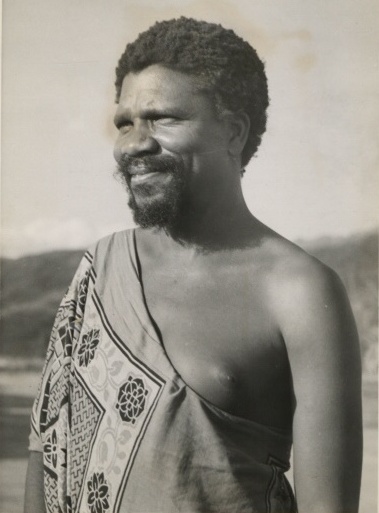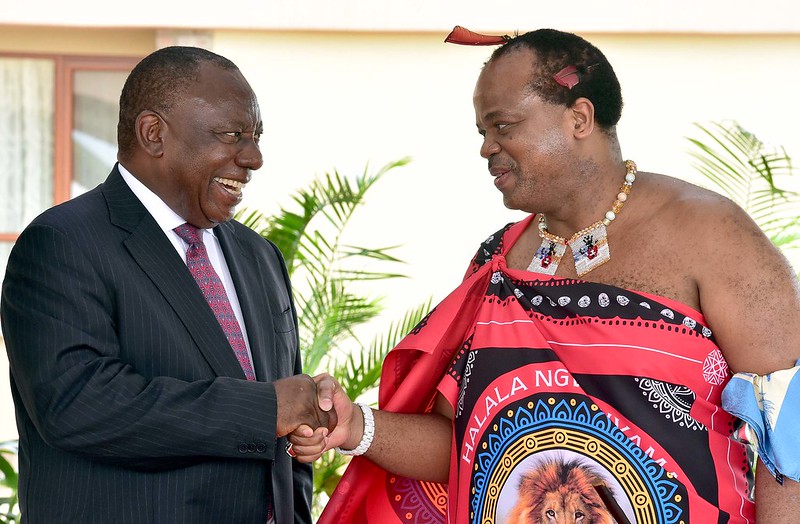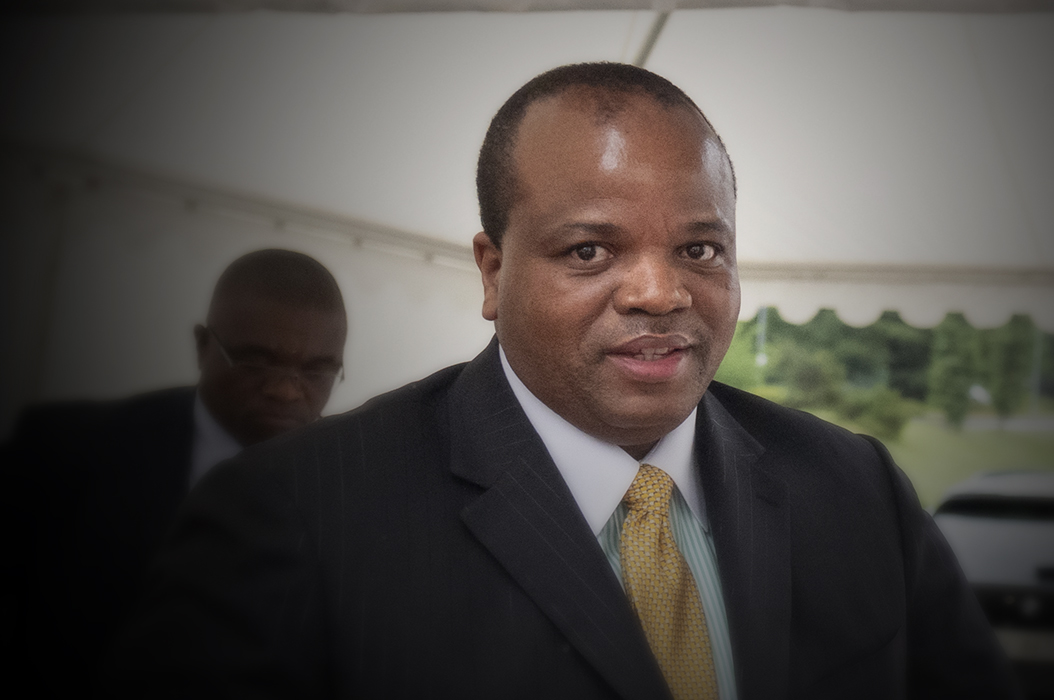Late on 28 June, news started emerging in the South African media that the monarch of eSwatini (formerly known as Swaziland), a landlocked kingdom in Southern Africa, had fled the country due to an ongoing protest movement. King Mswati III has ruled this kingdom, which is bordered by South Africa and Mozambique, with an iron fist since 1986. He is the last absolute monarch in Africa, and the masses have forced him to run.
The protests have been ongoing for weeks and have brought the country to a standstill. The banks are closed, as are shops and petrol stations. Internet access has also been cut and soldiers have been deployed against the mostly young protesters. The border with South Africa, the major artery of the economy of the country, is shut.
The initial demands of protesters were for democratic reforms, including that political parties be allowed to contest elections; and the right for the people to elect their own prime minister and government. The situation escalated on 25 June, when marches took place in over 10 locations, mainly in rural areas, despite a government ban on demonstrations. Police violently started cracking down on several peaceful marches, which intended to deliver petitions to the offices of the members of parliament, representing about a dozen of the country’s 59 predominantly rural constituencies. In response to the police repression, on the evening of 28 June, the youth took to the streets in Matsapha.
Police then used tear gas and live ammunition to try to disperse the crowds. Protests continued in the days following this, resulting in further clashes between security forces and demonstrators in multiple areas, including Msunduza, Lugongolweni, and Siphofaneni. Protesters reportedly set buildings and vehicles on fire, completely closing roads to some areas.
On Monday night, by the time the monarch’s plane took off, much of the luxurious property owned by himself and his associates - including supermarkets, cars, trucks etc. - were set ablaze amidst a riot that had erupted in Matsapha. This was a clear expression of class anger at the hated monarch and the corrupt gang surrounding him, in a country blighted by poverty, gross inequality and disease. These are unprecedented events and suggest that the masses have begun to lose the fear of the repressive state. This is very dangerous from the point of view of the regime.
"A child who is not embraced by the village will burn it down to feel its warmth.” ~ African Proverb #EswatiniProtests #eSwatini ✊🏿 pic.twitter.com/DPmrmOzxx5
— Mzilikazi wa Afrika (@IamMzilikazi) June 30, 2021
Decades in the making
The tiny, landlocked, mainly rural country of eSwatini is one of the least developed in the continent of Africa and faces severe economic and social problems. While 13 percent of its GDP is based on agriculture (with manufacturing making up 37 percent and government services 50 percent), 75 percent of the population are subsistence farmers. This large peasantry, involved in very unproductive farming with little investment, coupled with a lack of industrialisation, means the country is heavily dependent on imports. 90 percent of these come from South Africa, resulting in a close relationship between eSwatini’s monarchy and the South African bourgeoisie, who collectively drain the blood of the kingdom’s masses.
eSwatini’s income inequality is one of the highest in the world, and officially 40 percent of the population is unemployed. 60 percent live on less than $1.9 USD a day. On top of that, a full quarter of the population is HIV-positive. The country suffers from one of the lowest life expectancies in the world, at just 58 years, meaning that half of under-17-year-olds are orphaned. The youthful population (just 20 years on average) is reflected in the recent protests.
Aside from imperialist domination maintaining the kingdom in a state of backwardness (having been under British rule from 1906-1967), eSwatini’s poverty has been exacerbated by the corrupt and degenerate Dlamini dynasty. The monarchy was propped up by British imperialism after then-Swaziland’s independence in 1968. In the subsequent 50 years, the monarchy has looted the country’s resources and wealth to enrich itself, while the peasants, workers and poor have been forced to endure unbearable conditions.
The recent wave of democratic protests are the culmination of decades of repression and poverty since independence. With British imperialism preparing to withdraw, it attempted to strike up a deal with King Sobhuza II, who rejected the proposed role of constitutional monarch and instead contested the elections of 1967, in which the newly formed royalist party (Imbokodvo National Movement) won all the seats. After this, Sobhuza was formally recognised by British imperialism, as he was seen as a stabilising influence and bulwark against the revolutionary wave sweeping Africa in the 1960s.
 The monarchy was propped up by British imperialism after then-Swaziland acquired independence in 1968. King Sobhuza II subsequently concentrated absolute powers in the hands of the monarchy / Image: The National Archives UK, Flickr
The monarchy was propped up by British imperialism after then-Swaziland acquired independence in 1968. King Sobhuza II subsequently concentrated absolute powers in the hands of the monarchy / Image: The National Archives UK, Flickr
After the elections, Sobhuza consolidated himself as the absolute monarch of eSwatini. In 1973, he banned all political parties (a ban which remains in effect to this day), suspended the constitution and ruled by decree until his death in 1982, subjugating the masses and preventing them from having any democratic say over the running of the country.
When the current king, King Mswati III, took the reins from the regency of his mother, Queen-Mother Ntombfi Tfwala, he picked up where his father left off and continued the oppression of the masses. However, he was more brazen and arrogant than his predecessor. Under his reign, excesses such as buying all 18 of his wives high-end luxury cars like Rolls Royces and Bentleys, became the norm. While this was happening, the masses continued drowning in poverty, while capitalist corporations like the South African telecommunications giant MTN and other businesses linked to the king and his family, brutally exploited the people.
The ban on political parties maintained by King Mswati III proved especially unpopular, and this led to him making concessions such as the adoption of a constitution in 2005, which allowed for the election of MPs across 55 constituencies commonly known as Tinkhundla. These state-controlled, local government assemblies came to exist as a tool to stimulate recovery after the Second World War. Each representative of a Tinkhundla becomes a member of the House of Assembly, which in turn had little more than advisory powers.
In much the same way the Tsar treated his Duma, the monarchy could simply veto and dissolve the House of Assembly. And like in Tsarist Russia, this thin veneer of democracy is simply a disguise for the absolute authority of the despotic ruler. For too long, the masses have chafed under the heel of the monarchy, which has creamed off the wealth of the country to live its decadent lifestyles, while the poor endured intolerable hardship. All the resentment bubbling under the surface is now coming to a head.
Growing resistance
The recent wave of protests came about in response to a myriad of issues. The immediate trigger was police brutality against a peaceful march led by the Economic Freedom Fighters (EFF) Swaziland, a sister party of the Economic Freedom Fighters (EFF) in South Africa. This march was to commemorate the 48th anniversary of the banning of political parties on 12 April 1973. EFF Swaziland writes in its statement on the event that: “we were met with violence from the Royal Police.”
This violence from the police is an inherent characteristic of the rotten Eswatini state, which responds to any challenge to the Dlamini dynasty with brute force. After the reaction from the state, some MPs who serve in the House of Assembly pledged their support for the pro-democracy protests, and went as far as calling for an elected prime minister rather than an imposed prime minister.
Of course, these bourgeois politicians have no common interests with the workers, peasantry and poor. They simply want a more respectable ‘democratic’ shell for capitalist exploitation of the people, and a way to lay their own hands on more of the loot. Nevertheless, this dissent in the Assembly saw banned parties, including the People’s United Democratic Movement (PUDEMO), the Swazi Democratic Party and the Communist Party of eSwatini, come out in joint protests. In the heat of these protests, which were happening in rural areas and other towns like Matshapa, Mbabane, and Manzini, law student Thabani Nkomonye was brutally murdered by the Royal Police in murky circumstances, despite apparently not being involved in the protest movement.
This triggered an even bigger wave of protests, led by the EFF and the Communist Party, which saw thousands of EmaSwati march to Matshapa police station, and some to the Manzini Regional Headquarters to demand justice for Thabani Nkomonye under the banner of #JusticeForThabani. Once again, the Royal Police responded violently, and acted in the same fashion during the funeral of Thabani Nkomonye. This led to EFF Swaziland organising more marches, which turned into rolling mass action. This led to the delivery of petitions demanding justice and democratic rights across all 55 tinkhundla (constituencies), and created panic in the palace.
BREAKING NEWS: Eswatini Beverages where King Mswati owns shares burned by protestors.Tension is escalating in this tiny Kingdom, citizens want the King to surrender power. pic.twitter.com/FkHvQQGSUi
— Swazi News (@SwaziNews) June 30, 2021
The turning point
These events sent the regime into a panic. The movement was affecting all layers of society. The online EmaSwati newspaper, Swaziland News broke the story on 27 June that Mangaliso Nkwanyana, a bodyguard of the monarch, was arrested due to his support for the pro-democracy movement.
Days earlier, officers of the Royal Police had defied an order to arrest two MPs who were supporters of the pro-democracy protests. This shows divisions opening up in the security forces, which is very dangerous for the regime. A decree was issued by the King through his prime minister, Themba Masuku, that no petitions could be accepted, with the laughable excuse that this was to mitigate against super-spreader events. This provoked the masses further, to the point that businesses and properties linked to the Dlamini dynasty were burned. It was at this point that reports emerged that the King had fled.
On 29 June, the acting Prime Minister addressed the nation and imposed a curfew, which starts at 18:00 pm and ends at 05:00 am. This is all being done to exhaust the energy of the masses, who have been led by young workers and peasants in the rural and urban centres. Rumours are also rife that it is only a matter of time before the King decrees that the country is under martial law, due to the intensifying struggle. The King went on to decree that the internet must be shut down, and the monopolistic South African-based network operators like MTN and Vodacom obliged, due to their common interests with the monarchy.
However, the initial demands of the movement have shifted from vague calls for democracy within a constitutional monarchy to a fully-fledged republic. The King has now gone into hiding, refusing to make any public appearances, even though rumours are rife that he has fled either into South Africa or Mozambique. This has given the masses more confidence, while at the same time, the security forces are using the lack of coverage due to the internet ban as a means to dish out terror like never before.
What is next?
The EmaSwati masses, who are largely from peasant backgrounds, must keep up the fight against the cruel and decadent Dlamini regime, which has brutally exploited the working class and peasantry in eSwatini. We have seen street fights in Mbabane, Manzini, and other urbanised centres, where there is a greater presence of the working class, and it is clear the masses are ready to fight to the death if they must. The flight of the monarch shows that the ruling class is on the backfoot. But now the masses must finish the job.
The first and most important call must be for a general strike and popular insurrection in eSwatini, with the aim of overthrowing the monarchy. Action committees must be set up in all factories, neighbourhoods and schools and connected on local and national levels, in order to coordinate the struggle. Galvanised around the slogan for a democratic republic, such a strike will paralyse the country, cripple the ailing regime, and set the stage for the working class and peasantry to take power. This must be organised quickly and decisively, so as not to allow the counter-revolution to regain its footing.
We fully support the call for a republic with full democratic rights. However, the decrepit state of eSwatini’s capitalist system, bound hand and foot to the bourgeoisie in South Africa, is incapable of accomplishing this demand or resolving the deep social and economic crises in the country. The movement’s aspirations can only be achieved by the independent action of the workers and peasantry, with committees of workers taking the lead. The masses can have no faith in the bourgeois ‘democratic forces’ in the movement and in parliament, which are tied to the interests of the South African bourgeoisie, and who will inevitably betray the masses.
 President of South Africa, Cyril Ramaphosa, and Kim Mswati III. The regime in eSwatini is dependent on support from the rotten ruling class in South Africa. The revolution in eSwatini is also intimately connected to the revolution in South Africa / Image: GovernmentZA, Flickr
President of South Africa, Cyril Ramaphosa, and Kim Mswati III. The regime in eSwatini is dependent on support from the rotten ruling class in South Africa. The revolution in eSwatini is also intimately connected to the revolution in South Africa / Image: GovernmentZA, Flickr
The masses of eSwatini must also, as a matter of urgency, form Self-Defence Units (SDU), and Worker and Peasants’ Militias and Village Defence Units (VDU) to defend themselves from the violence of the state. They must also exploit the divisions in the security forces, and win over the wavering elements of the rank-and-file and junior officers in order to secure the success of the insurrection.
What we are seeing is the opening shots of a revolutionary movement, which must be generalised across the country, then spread beyond its borders, in order to break out of its isolation. In particular, the small country of eSwatini is entirely dependent on South Africa. The survival of King Mswati III lies in the support he receives from the corrupt and degenerate South African ruling class. Therefore, the revolution of eSwatini must appeal for solidarity from their brothers and sisters of the powerful South African working class, who are exploited and repressed in turn by the same capitalist system and bourgeois regime. The task of the working class across Africa and the world must offer the EmaSwati masses their solidarity like they did when the Palestinian masses were being ethnically cleansed by the rotten Zionist state of Israel.
We have already seen sympathetic demonstrations taking place on the South African side of the border. This should be built upon by the unions and could be the start of a broader solidarity movement in the best traditions of the South African working class, who have their own demands to fight for, and a common cause with the masses in eSwatini. The workers’ organisations in South Africa must organise a full workers’ boycott of eSwatini, to strip the main economic support column out from under the monarchy.
Genuine democracy and a decent existence for the masses will not be accomplished on a capitalist basis. Even if Africa’s last absolute monarch is consigned to the dustbin of history, along with the rest of his family and camarilla, eSwatini will remain a vassal of its larger neighbour, and the conditions of its people will not improve unless the revolution is spread into South Africa itself. Carried to its conclusion, the revolution in eSwatini could be the spark of a broader revolutionary wave in all of southern Africa where millions of people suffer under the same conditions.

